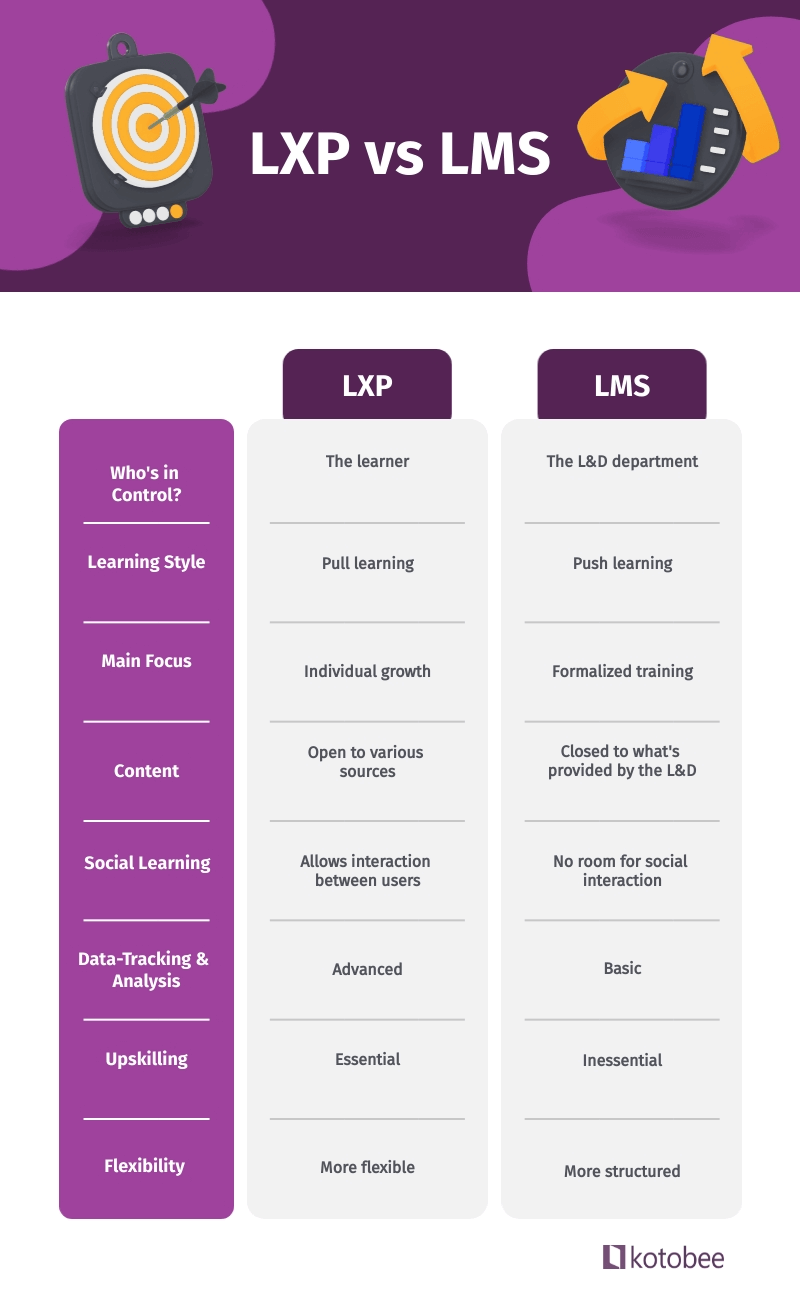LXP vs LMS: What’s the Best Learning Platform for You?
Thanks to technology, education has moved from classrooms and training halls to laptop screens. This is done through various learning platforms. One of them is the LMS, which many institutions use nowadays to train and track the progress of their employees and learners. But while most businesses and educational institutions around the world are accustomed to the LMS, there’s a new learning platform that’s increasingly rising in popularity.
This platform is the LXP, which helps bring the learners to the forefront and provides them with a more personalized approach to learning. And because some people confuse these two platforms, we’re going to look at LXP vs LMS, and how each affects the learner.

LMS vs LXP
There are many ways in which LXPs differ from LMSs. Whether it’s the learning strategy, the focus, or the hosting system, we can say that the LXP is designed for a more interactive type of learning than the LMS. So let’s look at the main points where these two platforms part.
Who’s in Control?
The first and most obvious difference between LXP and LMS is the person in charge of the learning process. LMS places the control in the hands of the L&D department. So every learner has certain tasks that are assigned to them (like completing a course or a reading), and their progress can easily be tracked and assessed.
LXPs, on the other hand, allow the learner to be in charge of their own learning process, which makes them self-directed learning platforms. With the help of AI, each employee is recommended learning material that goes with their skills and progress. This makes LXP more personal and customized to every learner’s needs. It also makes the learners responsible for their own development.
Push vs Pull Learning
When it comes to LMS, it’s the usual, traditional way of learning. Just like how curriculums are set in schools, LMS allows the L&D to choose the learning material and assign courses that fit the employees’ progress. To put it another way, the learning material is pushed upon the employees.
Conversely, as a result of putting the employee in control, the kind of learning in LXPs is known as “Pull Learning”, which basically means that the learning isn’t forced on them. The learner has the freedom of choosing the topic that suits them through the recommendations, or by using LXPs’ strong search features. This makes them more pulled in and eager to learn and collaborate.
Main Focus
One of the main differences between LMS and LXP is what they focus on. The whole idea of an LMS is assigning and tracking highly structured training material. This makes it a formalized learning platform that is less focused on the user and more focused on the business.
This isn’t the case with LXPs, which are considered consumer-focused. In other words, these platforms are more concerned with the individual growth of each learner than just ticking boxes and completing the assigned learning content.
Content Structure
Because there’s only the L&D who is in control, the learning material on an LMS is much more structured. There are courses assigned to the learner, and that’s all. If there’s a comment or a question asked, it has to be approved by the LMS admin before it appears on the platform.
The LXP, by contrast, is more of an open platform, pulling content from various resources. The users can share anything from videos and articles, to content from social media, and even interactive ebooks. Also, this platform relies more on microlearning, by sharing the information in tiny pieces. This makes it much more flexible and makes the learning process more engaging and fun.
Social Learning
There is no room for social interaction when it comes to LMSs. The idea of employees interacting with one another, commenting and liking each other’s learning resources and progress, is exclusive to LXPs. Some LXPs even offer the idea of mentorship by matching learners and mentors. This is a great functionality in LXPs, as learning in organizations nowadays is more peer-to-peer than before.
Data-Tracking and Analysis
Data-tracking and analysis is another area where LXPs are way more advanced than LMSs. Even though LMS platforms do track data, it’s usually limited to things like compilations of courses, scores, and drop-off rates. The main usage of such data is to assign the learning material suitable for each employee.
The data used in an LXP includes the whole learning process. By analyzing internal and external information, this system helps in choosing the right skills that the organization needs. It can analyze the learning data provided by the L&D department and the information provided by the employees to match each one with the right content. Moreover, how the content is doing (on the LXP and externally) is analyzed in order to increase employee engagement.
Upskilling
The main purpose of the LMS is to ensure that everyone in the organization has the necessary knowledge for the task. This is done by recommending the learning material that helps in achieving such a goal. The “skills” part of the job comes secondary to that.
Contrarily, upskilling and reskilling are an integral part of LXPs. The skill-based recommendation is one of the ways these platforms suggest content to users. Thanks to their advanced data-tracking and analysis, skill gaps are constantly addressed with learning content that suits each individual learner.

Choosing between LXP and LMS
Now that we’ve seen the difference between these two, you might be wondering which platform should you use? And the answer is simple: It all depends on the objectives you set for your organization.
LMSs work best for institutions that have a lot of mandatory training and a complex onboarding process. If the field you’re in is one of those where conveying certain messages to employees and tracking this progress is a must, then this is the platform for you.
You should consider LXPs, however, if you want to focus on the employee experience, individual growth, and upskilling. This works best for industries like entertainment, media, hospitality, and many others.
The good news is, you might not have to choose at all! Although they’re both learning platforms, they aren’t mutually exclusive. Many businesses find that they need the structure of the LMS, alongside the freedom of the LXP.
Nevertheless, if you’ve decided to move from one platform to another, you don’t have to make the switch right away! First, check your objectives, talk to your employees (who are the actual users of these platforms), look at your budget, then decide what works best for you.
Summing It Up
We can definitely say that both the LMS and the LXP serve different purposes. One gives the structure needed in some businesses to assign and track the learning material, while the other gives the freedom and opportunity for personal growth and social interaction. So before deciding which one to use, assess your objectives and go from there.
. .
Read More Here
What Is an LXP: Everything You Need to Know
What Does LMS Mean and How to Use It
Ebook and LMS Integration Using LTI















